《专业英语》自动化(翻译)
自动化专业英语(王宏文主编)课文翻译完整版
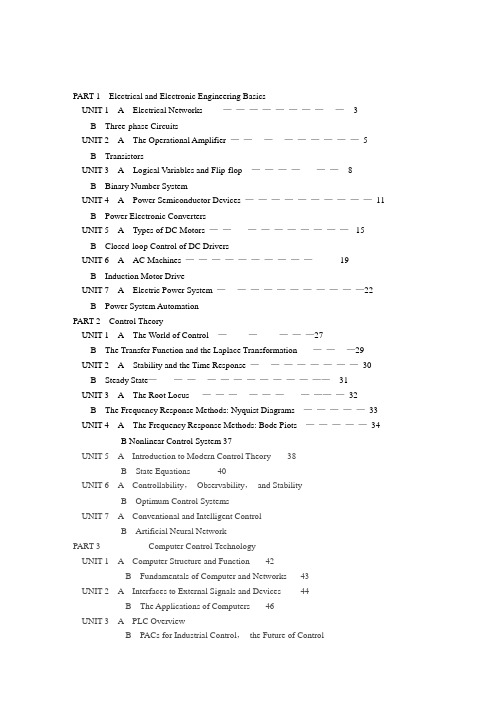
PART 1Electrical and Electronic Engineering BasicsUNIT 1A Electrical Networks - ————————- —- 3B Three-phase CircuitsUNIT 2A The Operational Amplifier ——- —- ——————5B TransistorsUNIT 3A Logical Variables and Flip-flop - ————- - ——- 8B Binary Number SystemUNIT 4A Power Semiconductor Devices ——————————11B Power Electronic ConvertersUNIT 5A Types of DC Motors ——- - ————————-15B Closed-loop Control of DC DriversUNIT 6A AC Machines ——————————- - - - -19B Induction Motor DriveUNIT 7A Electric Power System —- ——————————22B Power System AutomationPART 2Control TheoryUNIT 1A The World of Control - —- - - —- - - ———27B The Transfer Function and the Laplace Transformation - ——- —29UNIT 2A Stability and the Time Response —- ———————30B Steady State—- - ——- ——————————- 31UNIT 3A The Root Locus ———- ———- - ————32B The Frequency Response Methods: Nyquist Diagrams —————33UNIT 4A The Frequency Response Methods: Bode Piots —————34B Nonlinear Control System 37UNIT 5 A Introduction to Modern Control Theory 38B State Equations 40UNIT 6 A Controllability,Observability,and StabilityB Optimum Control SystemsUNIT 7 A Conventional and Intelligent ControlB Artificial Neural NetworkPART 3 Computer Control TechnologyUNIT 1 A Computer Structure and Function 42B Fundamentals of Computer and Networks 43UNIT 2 A Interfaces to External Signals and Devices 44B The Applications of Computers 46UNIT 3 A PLC OverviewB PACs for Industrial Control,the Future of ControlUNIT 4 A Fundamentals of Single—chip Microcomputer 49B Understanding DSP and Its UsesUNIT 5 A A First Look at Embedded SystemsB Embedded Systems DesignPART 4 Process ControlUNIT 1 A A Process Control System 50B Fundamentals of Process Control 52UNIT 2 A Sensors and Transmitters 53B Final Control Elements and ControllersUNIT 3 A P Controllers and PI ControllersB PID Controllers and Other ControllersUNIT 4 A Indicating InstrumentsB Control PanelsPART 5 Control Based on Network and InformationUNIT 1 A Automation Networking Application AreasB Evolution of Control System ArchitectureUNIT 2 A Fundamental Issues in Networked Control SystemsB Stability of NCSs with Network—induced DelayUNIT 3 A Fundamentals of the Database SystemB Virtual Manufacturing—A Growing Trend in AutomationUNIT 4 A Concepts of Computer Integrated ManufacturingB Enterprise Resources Planning and BeyondPART 6 Synthetic Applications of Automatic TechnologyUNIT 1 A Recent Advances and Future Trends in Electrical Machine DriversB System Evolution in Intelligent BuildingsUNIT 2 A Industrial RobotB A General Introduction to Pattern RecognitionUNIT 3 A Renewable EnergyB Electric VehiclesUNIT 1A 电路电路或电网络由以某种方式连接的电阻器、电感器和电容器等元件组成。
自动化专业英语全文翻译
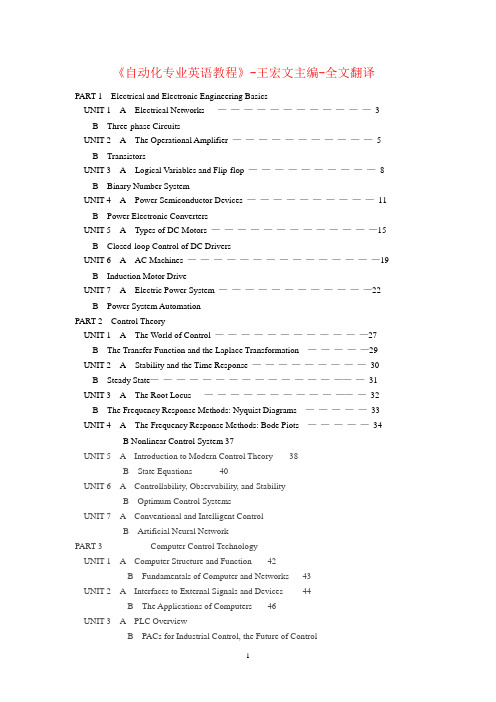
《自动化专业英语教程》-王宏文主编-全文翻译PART 1Electrical and Electronic Engineering BasicsUNIT 1A Electrical Networks ————————————3B Three-phase CircuitsUNIT 2A The Operational Amplifier ———————————5B TransistorsUNIT 3A Logical Variables and Flip-flop ——————————8B Binary Number SystemUNIT 4A Power Semiconductor Devices ——————————11B Power Electronic ConvertersUNIT 5A Types of DC Motors —————————————15B Closed-loop Control of DC DriversUNIT 6A AC Machines ———————————————19B Induction Motor DriveUNIT 7A Electric Power System ————————————22B Power System AutomationPART 2Control TheoryUNIT 1A The World of Control ————————————27B The Transfer Function and the Laplace Transformation —————29 UNIT 2A Stability and the Time Response —————————30B Steady State—————————————————31 UNIT 3A The Root Locus —————————————32B The Frequency Response Methods: Nyquist Diagrams —————33 UNIT 4A The Frequency Response Methods: Bode Piots —————34B Nonlinear Control System 37UNIT 5 A Introduction to Modern Control Theory 38B State Equations 40UNIT 6 A Controllability, Observability, and StabilityB Optimum Control SystemsUNIT 7 A Conventional and Intelligent ControlB Artificial Neural NetworkPART 3 Computer Control TechnologyUNIT 1 A Computer Structure and Function 42B Fundamentals of Computer and Networks 43UNIT 2 A Interfaces to External Signals and Devices 44B The Applications of Computers 46UNIT 3 A PLC OverviewB PACs for Industrial Control, the Future of ControlUNIT 4 A Fundamentals of Single-chip Microcomputer 49B Understanding DSP and Its UsesUNIT 5 A A First Look at Embedded SystemsB Embedded Systems DesignPART 4 Process ControlUNIT 1 A A Process Control System 50B Fundamentals of Process Control 52UNIT 2 A Sensors and Transmitters 53B Final Control Elements and ControllersUNIT 3 A P Controllers and PI ControllersB PID Controllers and Other ControllersUNIT 4 A Indicating InstrumentsB Control PanelsPART 5 Control Based on Network and InformationUNIT 1 A Automation Networking Application AreasB Evolution of Control System ArchitectureUNIT 2 A Fundamental Issues in Networked Control SystemsB Stability of NCSs with Network-induced DelayUNIT 3 A Fundamentals of the Database SystemB Virtual Manufacturing—A Growing Trend in AutomationUNIT 4 A Concepts of Computer Integrated ManufacturingB Enterprise Resources Planning and BeyondPART 6 Synthetic Applications of Automatic TechnologyUNIT 1 A Recent Advances and Future Trends in Electrical Machine DriversB System Evolution in Intelligent BuildingsUNIT 2 A Industrial RobotB A General Introduction to Pattern RecognitionUNIT 3 A Renewable EnergyB Electric VehiclesUNIT 1A 电路电路或电网络由以某种方式连接的电阻器、电感器和电容器等元件组成。
自动化专业英语(翻译)P4U1教学课件

P4UIA A Process Control System
第四部分第一单元课文A
过程控制系统
5. 参考译文
A 过程控制系统
此部分的主要目的是满足读者对自动过程控制的需要和激励 读者来学习。自动过程控制与持续过程变量、温度、压力、流量、 成分和期望操作值一类的量有关。正如我们在后续的章节中所看 到的,过程本身是动态的。变化不断发生,并且如果激励未加入, 重要的过程变量——与安全有关的变量、产品质量和生产率—— 将不能获得期望值。 为了强化概念,让我们来考虑一个过程流通过浓缩流加热的 热变换器,其过程框图如图4-1A-1
I P
FY 10
图4-1B-1 I/P 传感器
P4UIB Fundamentals of Process Control
第四部分第一单元课文B
过程控制的基本要素
输入信号在4到20毫安之间,输出信号在3到15表压之间。其他 传感器还有:气动-电流传感器(P/I),电压-气动传感器 (E/P),气动-电压传感器(P/E)等等。
P4UIA A Process Control System
第四部分第一单元课文A
过程控制系统
① ② ③
测量(M ):传感器和热偶电阻的组合元件经常测量被控变量。 设定(D ):基于测量值,控制器决定怎样维持变量在期望值。 执行(A ):作为控制器决定后的结果,系统必须采取一定的 措施,通常有终端控制元件完成。 如上所述,在每一个控制系统中这三个基本操作:M、D 和A都会存在。在某些系统中,决定-执行操作相当简单,而在 另一些系统中操作很复杂。工程人员设计控制系统时必须确保 采取的措施要影响控制变量,也就是说,采取的措施要影响测 量值。否则,系统是不可控的且有可能弊大于利。
自动化专业英语第四版课文翻译
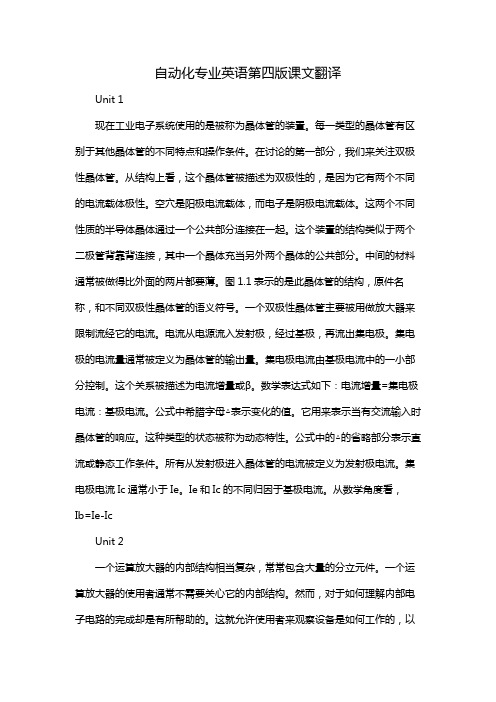
自动化专业英语第四版课文翻译Unit 1现在工业电子系统使用的是被称为晶体管的装置。
每一类型的晶体管有区别于其他晶体管的不同特点和操作条件。
在讨论的第一部分,我们来关注双极性晶体管。
从结构上看,这个晶体管被描述为双极性的,是因为它有两个不同的电流载体极性。
空穴是阳极电流载体,而电子是阴极电流载体。
这两个不同性质的半导体晶体通过一个公共部分连接在一起。
这个装置的结构类似于两个二极管背靠背连接,其中一个晶体充当另外两个晶体的公共部分。
中间的材料通常被做得比外面的两片都要薄。
图1.1表示的是此晶体管的结构,原件名称,和不同双极性晶体管的语义符号。
一个双极性晶体管主要被用做放大器来限制流经它的电流。
电流从电源流入发射极,经过基极,再流出集电极。
集电极的电流量通常被定义为晶体管的输出量。
集电极电流由基极电流中的一小部分控制。
这个关系被描述为电流增量或β。
数学表达式如下:电流增量=集电极电流:基极电流。
公式中希腊字母△表示变化的值。
它用来表示当有交流输入时晶体管的响应。
这种类型的状态被称为动态特性。
公式中的△的省略部分表示直流或静态工作条件。
所有从发射极进入晶体管的电流被定义为发射极电流。
集电极电流Ic通常小于Ie。
Ie和Ic的不同归因于基极电流。
从数学角度看,Ib=Ie-IcUnit 2一个运算放大器的内部结构相当复杂,常常包含大量的分立元件。
一个运算放大器的使用者通常不需要关心它的内部结构。
然而,对于如何理解内部电子电路的完成却是有所帮助的。
这就允许使用者来观察设备是如何工作的,以及表明它作为一个功能单元的一些局限性。
运算放大器的内部电子线路可以被分为三个功能单元。
图1.7即是一个运算放大器内部功能的简图。
注意每一个功能都被附在一个三角形内。
电子图表中用三角形来表示放大功能。
这个简图显示了运算放大器有三个基本的放大功能。
这些功能一般叫作放大级。
一个放大级包含一或更多有源器件,所有相联元件需实现放大。
第一阶段或一个运算放大器的输入常常是一个差动放大器。
自动化专业英语原文和翻译

自动化专业英语原文和翻译引言概述:自动化专业是现代工程技术领域中的重要学科,涵盖了自动控制系统、机器人技术、工业自动化等多个方面。
在学习和实践中,掌握和理解自动化专业的英文术语和翻译是非常重要的。
本文将从五个大点出发,详细阐述自动化专业英语原文和翻译的相关内容。
正文内容:1. 自动控制系统(Automatic Control System)1.1 控制器(Controller)1.2 传感器(Sensor)1.3 执行器(Actuator)1.4 反馈(Feedback)1.5 稳定性(Stability)2. 机器人技术(Robotics)2.1 机器人(Robot)2.2 机械臂(Manipulator)2.3 传感器(Sensor)2.4 视觉系统(Vision System)2.5 自主导航(Autonomous Navigation)3. 工业自动化(Industrial Automation)3.1 自动化生产线(Automated Production Line)3.2 人机界面(Human-Machine Interface)3.3 传感器网络(Sensor Network)3.4 电气控制(Electrical Control)3.5 数据采集(Data Acquisition)4. 自动化软件(Automation Software)4.1 PLC编程(PLC Programming)4.2 HMI设计(HMI Design)4.3 数据分析(Data Analysis)4.4 模拟仿真(Simulation)4.5 系统集成(System Integration)5. 自动化工程(Automation Engineering)5.1 项目管理(Project Management)5.2 自动化设计(Automation Design)5.3 系统调试(System Debugging)5.4 故障诊断(Fault Diagnosis)5.5 性能优化(Performance Optimization)总结:综上所述,自动化专业英语原文和翻译是自动化工程师必备的技能之一。
自动化专业英语原文和翻译

自动化专业英语原文和翻译Automation in the Manufacturing Industry: An OverviewIntroduction:Automation plays a crucial role in the manufacturing industry, revolutionizing production processes and enhancing efficiency. This article provides an in-depth analysis of the concept of automation in the manufacturing sector, highlighting its benefits, challenges, and future prospects. It also includes a translation of the text into English.Section 1: Definition and Importance of AutomationAutomation refers to the use of technology and machinery to perform tasks with minimal human intervention. In the manufacturing industry, automation is essential for streamlining operations, reducing costs, and improving product quality. It allows companies to achieve higher production rates, increased precision, and improved safety standards.Section 2: Benefits of Automation in Manufacturing2.1 Increased ProductivityAutomation enables manufacturers to produce goods at a faster rate, leading to increased productivity. With the use of advanced robotics and machinery, repetitive tasks can be performed efficiently, allowing workers to focus on more complex and creative aspects of production.2.2 Enhanced Quality ControlAutomated systems ensure consistency and accuracy in manufacturing processes, leading to improved product quality. By minimizing human error, automation reduces defects and variations, resulting in higher customer satisfaction and reduced waste.2.3 Cost ReductionAutomation helps in reducing labor costs by replacing manual work with machines and robots. Although initial investment costs may be high, long-term savings are significant due to increased efficiency and reduced dependence on human labor.2.4 Improved Workplace SafetyAutomation eliminates the need for workers to perform hazardous or physically demanding tasks. Robots and machines can handle tasks that pose risks to human health and safety, thereby reducing workplace accidents and injuries.2.5 Increased FlexibilityAutomated systems can be easily reprogrammed to adapt to changing production requirements. This flexibility allows manufacturers to respond quickly to market demands, introduce new products, and customize production processes.Section 3: Challenges in Implementing Automation3.1 Initial InvestmentImplementing automation requires substantial capital investment for purchasing and integrating machinery, software, and training. Small and medium-sized enterprises (SMEs) may face financial constraints in adopting automation technologies.3.2 Workforce AdaptationAutomation may lead to job displacement, as certain tasks previously performed by humans are now handled by machines. Companies need to provide training and re-skilling opportunities to ensure a smooth transition for their workforce.3.3 Technical ComplexityAutomation systems often involve complex integration of various technologies, such as robotics, artificial intelligence, and data analytics. Companies must have skilled personnel capable of managing and maintaining these systems effectively.Section 4: Future Trends in Automation4.1 Collaborative RobotsCollaborative robots, also known as cobots, are designed to work alongside humans, assisting them in tasks that require precision and strength. These robots can improve productivity and safety by working in close proximity to humans without the need for extensive safety measures.4.2 Internet of Things (IoT) IntegrationThe integration of automation systems with the Internet of Things allows for real-time monitoring and control of manufacturing processes. IoT enables seamless communication between machines, sensors, and data analytics platforms, leading to predictive maintenance and optimized production.4.3 Artificial Intelligence (AI)AI technologies, such as machine learning and computer vision, enable automation systems to learn and adapt to new situations. AI-powered robots can analyze data, make decisions, and perform complex tasks with minimal human intervention, revolutionizing the manufacturing industry.Conclusion:Automation has become an integral part of the manufacturing industry, offering numerous benefits such as increased productivity, enhanced quality control, cost reduction, improved workplace safety, and increased flexibility. While challenges exist, such as initial investment and workforce adaptation, the future of automation looks promising with the emergence of collaborative robots, IoT integration, and artificial intelligence. Embracing automation technologies will undoubtedly pave the way for a more efficient and competitive manufacturing sector.Translation:自动化在创造业中的应用:概述简介:自动化在创造业中扮演着重要的角色,革新了生产过程,提高了效率。
自动化专业英语原文和翻译

自动化专业英语原文和翻译Automation in the Field of EngineeringIntroduction:Automation has become an integral part of various industries, including the field of engineering. It involves the use of technology and machines to perform tasks with minimal human intervention. This text aims to provide a comprehensive overview of automation in the engineering field, covering its importance, applications, and future prospects. Additionally, an English translation of the original text will be provided.Importance of Automation in Engineering:Automation plays a crucial role in improving efficiency, accuracy, and productivity in engineering processes. By automating repetitive and time-consuming tasks, engineers can focus on more complex and critical aspects of their work. It also reduces the risk of human errors, leading to higher quality output. Moreover, automation enables engineers to monitor and control systems remotely, enhancing safety and minimizing operational risks.Applications of Automation in Engineering:1. Manufacturing and Assembly: Automation is extensively used in manufacturing industries to streamline production processes. Automated systems can perform tasks such as assembly, welding, and material handling with precision and speed. This leads to increased production rates, reduced costs, and improved product quality.2. Robotics: Robotics is a significant application of automation in engineering. Robots are used in various sectors, including automotive, healthcare, and aerospace industries. They can perform complex tasks with high accuracy, consistency, and repeatability. Examples include robotic arms used in assembly lines and surgical robots in medical procedures.3. Control Systems: Automation is vital in control systems, which regulate and optimize various engineering processes. Programmable Logic Controllers (PLCs) and Distributed Control Systems (DCS) are commonly used to automate tasks such as temperature control, pressure regulation, and flow management. This ensures efficient operation and minimizes manual intervention.4. Energy Management: Automation plays a crucial role in energy management systems, optimizing energy consumption and reducing waste. Automated systems can monitor and control energy usage in buildings, factories, and power plants. This leads to energy savings, cost reduction, and environmental sustainability.Future Prospects of Automation in Engineering:The future of automation in engineering looks promising, with several emerging trends and technologies. Some of these include:1. Artificial Intelligence (AI): AI is revolutionizing automation by enabling machines to learn, adapt, and make decisions. Machine Learning algorithms can analyze vast amounts of data to optimize processes and predict failures. AI-powered systems can also perform complex tasks that were previously only possible for humans.2. Internet of Things (IoT): IoT connects various devices and systems, allowing them to communicate and share data. In engineering, IoT enables remote monitoring, predictive maintenance, and real-time data analysis. This leads to improved efficiency, reduced downtime, and enhanced decision-making.3. Digital Twin: A digital twin is a virtual replica of a physical system or process. It allows engineers to simulate and optimize operations, predict performance, and identify potential issues. Digital twins enable engineers to make informed decisions and improve system performance.4. Cybersecurity: As automation becomes more prevalent, ensuring the security of automated systems is crucial. Cybersecurity measures are essential to protect against potential threats and vulnerabilities. This includes implementing secure communication protocols, encryption techniques, and access control mechanisms.Translation:自动化在工程领域的应用介绍:自动化已成为包括工程领域在内的各个行业的重要组成部分。
自动化专业英语翻译

A: Electrical NetworksAn electrical circuit or network is composed of elements such as resistors, inductors, and capacitors connected together in some manner. If the network contains no energy sources, such as batteries or electrical generators, it is known as a passive network. On the other hand, if one or more energy sources are present, the resultant combination is an active network. In studying the behavior of an electrical network, we are interested in determining the voltages and currents that exist within the circuit. Since a network is composed of passive circuit elements, we must first define the electrical characteristics of these elements.一个电路由一些元件,如电阻、电感和电容,以某种方式连接组成。
如果电路中不包括电源,如电池或者发电机,则称为无源网络。
另一方面,如果电路中有一个或多个电源,称为有源网络。
在研究电路的行为中,确定存在于电路中的电压和电流是我们感兴趣的。
由于一个电路网络由无源元件组成,我们必须首先定义这些元件的电的特性。
In the case of a resistor, the voltage-current relationship is given by Ohm's law, which states that the voltage across the resistor is equal to the current through the resistor multiplied by the value of the resistance. Mathematically, this is expressed as欧姆定律给出了电阻的电压—电流关系:电阻两端的电压等于通过电阻的电流乘以电阻的阻值。
自动化专业英语 原文和翻译 P1U5
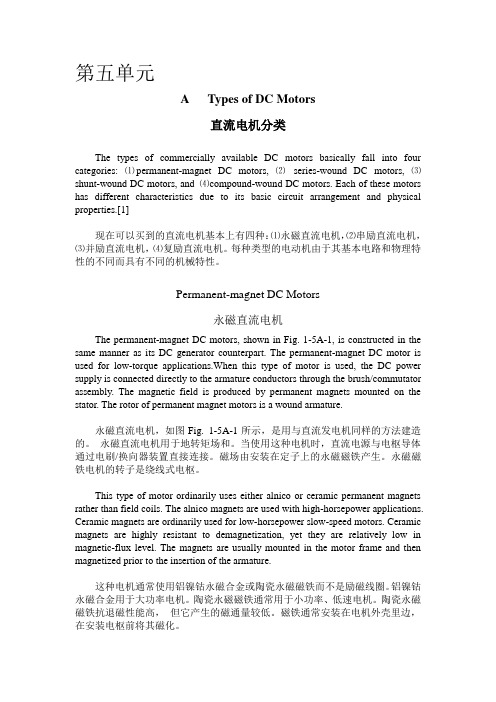
第五单元A Types of DC Motors直流电机分类The types of commercially available DC motors basically fall into four categories: ⑴permanent-magnet DC motors, ⑵series-wound DC motors, ⑶shunt-wound DC motors, and ⑷compound-wound DC motors. Each of these motors has different characteristics due to its basic circuit arrangement and physical properties.[1]现在可以买到的直流电机基本上有四种:⑴永磁直流电机,⑵串励直流电机,⑶并励直流电机,⑷复励直流电机。
每种类型的电动机由于其基本电路和物理特性的不同而具有不同的机械特性。
Permanent-magnet DC Motors永磁直流电机The permanent-magnet DC motors, shown in Fig. 1-5A-1, is constructed in the same manner as its DC generator counterpart. The permanent-magnet DC motor is used for low-torque applications.When this type of motor is used, the DC power supply is connected directly to the armature conductors through the brush/commutator assembly. The magnetic field is produced by permanent magnets mounted on the stator. The rotor of permanent magnet motors is a wound armature.永磁直流电机,如图Fig. 1-5A-1所示,是用与直流发电机同样的方法建造的。
自动化专业英语(翻译)P4U2教学课件

P4U2A
Sensors and Transmitters
KT
第四部分第二单元mA 0.08 200psig 0psig 200psig psig
考虑的另一个例子是范围在100~300°F的气动温度传感器/ 热敏电阻。增益为
KT 15psig 3psig 12psig psig 0.06 300 F 100 F 200 F F
KT G( s ) s 1
或
KT G(s) 2 s 2s 1
P4U2B Final Control Elements and Controllers 第四部分第二单元课文B 终端控制元件和控制器
B 终端控制元件和控制器
1. 课文内容简介:形象地介绍《过程控制系统》中控制 阀、反馈控制器的功能和作用,通过换热器和液位控制 的例子,生动地解释了“无信号则关”、“无信号则 开”、正反馈、负反馈等非常重要的控制概念。 2. 温习《过程控制系统》中有关调节阀的内容。 3. 生词与短语
标称增益为:
P4U2A
Sensors and Transmitters
第四部分第二单元课文A
传感器和变送器
KT
16 Fmax
此表达式说明增益不是常量,而是一个时间的函数。流量越 大,增益越大。明确的说,
F At F max KT K T
也就是说,传感器/变送器的增益是输出测量范围与输入测 量范围的比率。 上述的两个例子表明传感器/变送器的增益是超过其完全操 作范围的常量,大多数传感器/变送器都是这种情况;然而,也 有一些象用于测量流的微分压力h传感器不是这种情况的例子。 微分压力传感器冷处理孔处的微分压力。微分压力与测定体积流 2 的速率F的平方有关,即 F ah 。
自动化专业英语原文和翻译
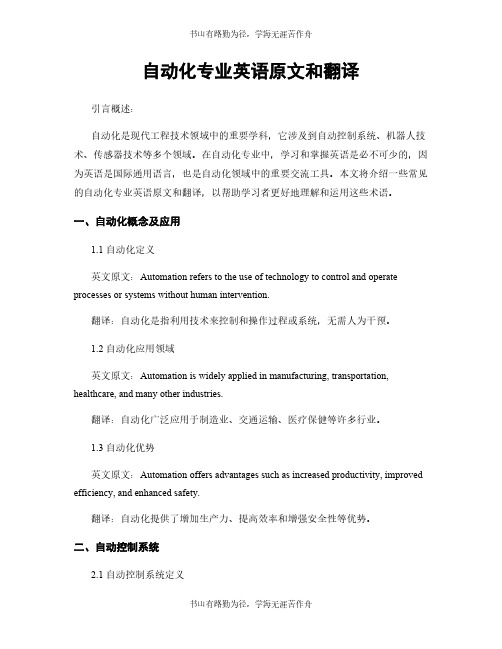
自动化专业英语原文和翻译引言概述:自动化是现代工程技术领域中的重要学科,它涉及到自动控制系统、机器人技术、传感器技术等多个领域。
在自动化专业中,学习和掌握英语是必不可少的,因为英语是国际通用语言,也是自动化领域中的重要交流工具。
本文将介绍一些常见的自动化专业英语原文和翻译,以帮助学习者更好地理解和运用这些术语。
一、自动化概念及应用1.1 自动化定义英文原文:Automation refers to the use of technology to control and operate processes or systems without human intervention.翻译:自动化是指利用技术来控制和操作过程或系统,无需人为干预。
1.2 自动化应用领域英文原文:Automation is widely applied in manufacturing, transportation, healthcare, and many other industries.翻译:自动化广泛应用于制造业、交通运输、医疗保健等许多行业。
1.3 自动化优势英文原文:Automation offers advantages such as increased productivity, improved efficiency, and enhanced safety.翻译:自动化提供了增加生产力、提高效率和增强安全性等优势。
二、自动控制系统2.1 自动控制系统定义英文原文:An automatic control system is a set of devices that manage and regulate the behavior of a system or process automatically.翻译:自动控制系统是一组设备,能够自动管理和调节系统或过程的行为。
2.2 自动控制系统组成英文原文:An automatic control system consists of sensors, actuators, controllers, and communication networks.翻译:自动控制系统由传感器、执行器、控制器和通信网络组成。
自动化专业英语 翻译

1.1In recent years the performance requirements for process plant have become increasingly difficult to satisfy. Stronger competition, tougher ( 更加严苛的) environmental and safety regulations ( 法规), and rapidly changing economic conditions have been key factors in the tightening of plant product quality specifications (产品质量规范).A further complication (复杂) is that modern processes have become more difficult to operate because of the trend toward larger, more highly integrated plants with smaller surge capacities (谐振能力) between the various processing units. Such plants give the operators little opportunity to prevent upsets ( 扰乱) from propagating from one unit to other interconnected units. In view of (考虑到,由于) the increased emphasis placed on safe, efficient plant operation, it is only natural that the subject of process control has become increasingly important in recent years. In fact, without process control it would not be possible to operate most modern processes safely and profitably (有利的), while satisfying plant quality standards.近年来,对过程系统的性能改善需求变得越来越艰难. 更为激烈的竞争,更加严格的环境和安全规范,以及快速变化的经济条件都是加强工厂产品质量规范的关键因素更为复杂的情况是,由于现代创造业朝着规模更大,集成度更高的方向发展,而使不同的加工环节之间的应变能力更低, 所以加工过程更难控制近年来,考虑到工业创造逐渐加强的安全、高效需求,过程控制这个课题变得越来越受重视. 实际上,对于大多数现代工业,要满足安全、高效,产品质量的要求,没有控制系统是不可能的.It is assumed that the inlet and outlet flow rates are identical (相同的) and that the liquid density ρ(rho) remains consant, that is, the temperature variations are small enough that the temperature dependence of ρcan be neglected.Under these conditions the volu me V of liquid in the tank remains constant.假设输入和输出流量是相等的,并且液体密度保持恒定,也就是说温度变化足够小,密度对温度的影响可以忽稍不计. 在这些条件下,槽内液体的体积保持恒定Use a larger tank. If a larger tank is used, fluctuations (波动) in Ti will tend to be damped out (阻尼,衰减) due to the larger thermal capacitance of the tank contents. However, increased volume of tankage would be an expensive solution for an industrial plant due to the increased capital costs of the larger tank.Note that this approach is analogous to the use of water baths in chemistry laboratories where the large thermal capacitance of the bath serves as a heat sink ( 散热装置) and thus provides an isothermal (恒温的) environment for a small-scale research apparatus (仪器). 使用一个更大的槽. 如果使用更大的槽,因为更大的热容,Ti 的波动会趋向于衰减. 然而,体积增加使得开支增加,会使工厂系统的解决方案变得更加昂贵.要指出的是这个方法类似于化学实验室中水缸的使用,水缸的大热容量可以看做散热装置,因此可以为小型研究仪器提供一个恒温环境.Note that in feedforward control, the controlled variable T is not measured.在前馈控制中,被控变量T 是没有被测量的.1.2The motivation of using feedback, illustrated ( 说明) by the examples in Section (1), is somewhat oversimplified.In these examples, the use of feedback is shown to be for the purpose of reducing the error between the reference input and the system output.However, the significance of theeffects of feedback in control systems is more complex than is demonstrated by these simple examples.The reduction of system error is merely ( 仅仅) one of the many important effects that feedback may have upon a system. We show in the following sections that feedback also has effects on such system performance characteristics as stability (稳定性), bandwidth (带宽), overall gain (总增益), disturbance (扰动), and sensitivity (灵敏度).第一节事例中,应用反馈的动机有些过于简单。
自动化专业英语(王宏文)全文翻译
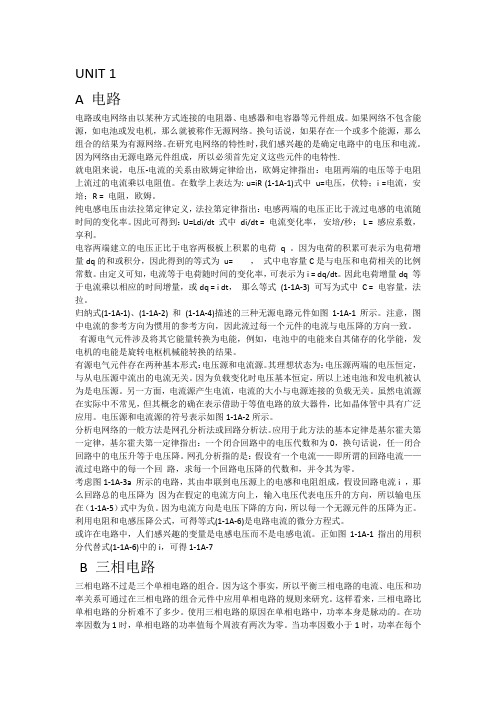
UNIT 1A 电路电路或电网络由以某种方式连接的电阻器、电感器和电容器等元件组成。
如果网络不包含能源,如电池或发电机,那么就被称作无源网络。
换句话说,如果存在一个或多个能源,那么组合的结果为有源网络。
在研究电网络的特性时,我们感兴趣的是确定电路中的电压和电流。
因为网络由无源电路元件组成,所以必须首先定义这些元件的电特性.就电阻来说,电压-电流的关系由欧姆定律给出,欧姆定律指出:电阻两端的电压等于电阻上流过的电流乘以电阻值。
在数学上表达为: u=iR (1-1A-1)式中u=电压,伏特;i =电流,安培;R = 电阻,欧姆。
纯电感电压由法拉第定律定义,法拉第定律指出:电感两端的电压正比于流过电感的电流随时间的变化率。
因此可得到:U=Ldi/dt 式中di/dt = 电流变化率,安培/秒;L = 感应系数,享利。
电容两端建立的电压正比于电容两极板上积累的电荷q 。
因为电荷的积累可表示为电荷增量dq的和或积分,因此得到的等式为u= ,式中电容量C是与电压和电荷相关的比例常数。
由定义可知,电流等于电荷随时间的变化率,可表示为i = dq/dt。
因此电荷增量dq 等于电流乘以相应的时间增量,或dq = i dt,那么等式(1-1A-3) 可写为式中C = 电容量,法拉。
归纳式(1-1A-1)、(1-1A-2) 和(1-1A-4)描述的三种无源电路元件如图1-1A-1所示。
注意,图中电流的参考方向为惯用的参考方向,因此流过每一个元件的电流与电压降的方向一致。
有源电气元件涉及将其它能量转换为电能,例如,电池中的电能来自其储存的化学能,发电机的电能是旋转电枢机械能转换的结果。
有源电气元件存在两种基本形式:电压源和电流源。
其理想状态为:电压源两端的电压恒定,与从电压源中流出的电流无关。
因为负载变化时电压基本恒定,所以上述电池和发电机被认为是电压源。
另一方面,电流源产生电流,电流的大小与电源连接的负载无关。
虽然电流源在实际中不常见,但其概念的确在表示借助于等值电路的放大器件,比如晶体管中具有广泛应用。
自动化专业英语原文和翻译

自动化专业英语原文和翻译Abstract:This document provides a comprehensive overview of the field of automation, including its definition, applications, and current trends. It also includes a detailed explanation of key terms and concepts related to automation. The document aims to serve as a resource for professionals and students in the field of automation, as well as anyone interested in gaining a deeper understanding of this rapidly evolving discipline.1. IntroductionAutomation is the use of technology to perform tasks with minimal human intervention. It involves the design, development, and implementation of systems that can operate autonomously or semi-autonomously. Automation has revolutionized various industries, including manufacturing, transportation, healthcare, and agriculture, by increasing efficiency, productivity, and safety.2. Definition and ScopeAutomation encompasses a wide range of technologies and processes, such as robotics, artificial intelligence, machine learning, and control systems. It involves the integration of hardware and software components to create intelligent systems capable of performing complex tasks. The scope of automation includes industrial automation, process automation, home automation, and office automation.3. Applications of Automation3.1 Manufacturing AutomationManufacturing automation involves the use of machines and robotic systems to automate production processes. It includes tasks such as assembly, packaging, material handling, and quality control. Automation in manufacturing has led to increased production rates, improved product quality, and reduced labor costs.3.2 Transportation AutomationTransportation automation aims to automate various aspects of transportation systems, including vehicles, traffic control, and logistics. It includes technologies such as autonomous vehicles, intelligent transportation systems, and automated warehouses. Automation in transportation can enhance safety, reduce congestion, and optimize resource utilization.3.3 Healthcare AutomationHealthcare automation involves the use of technology to streamline healthcare processes and improve patient care. It includes electronic medical records, telemedicine, robotic surgery, and automated drug dispensing systems. Automation in healthcare can enhance accuracy, reduce errors, and improve overall efficiency.3.4 Agriculture AutomationAgriculture automation focuses on automating agricultural processes to increase productivity and reduce labor requirements. It includes technologies such as precision farming, automated irrigation systems, and robotic harvesting. Automation in agriculture can optimize resource usage, improve crop yields, and minimize environmental impact.4. Key Terms and Concepts4.1 RoboticsRobotics is the branch of automation that deals with the design, construction, and operation of robots. Robots are programmable machines capable of carrying out tasks autonomously or under human supervision. They can be used in various industries for tasks that are dangerous, repetitive, or require high precision.4.2 Artificial Intelligence (AI)Artificial Intelligence refers to the ability of machines to mimic human intelligence and perform tasks that typically require human intelligence, such as speech recognition,decision-making, and problem-solving. AI is a key component of many automation systems, enabling machines to learn from data and adapt to changing conditions.4.3 Machine LearningMachine Learning is a subset of AI that focuses on the development of algorithms and models that allow machines to learn from data and make predictions or decisions without explicit programming. Machine learning algorithms are used in various automation applications, such as image recognition, natural language processing, and predictive maintenance.4.4 Control SystemsControl systems are used to monitor and regulate the behavior of machines and processes. They involve sensors, actuators, and feedback mechanisms to maintain desired performance and stability. Control systems are essential in automation to ensure accurate and reliable operation of automated systems.5. Current Trends in Automation5.1 Internet of Things (IoT)The Internet of Things refers to the network of interconnected devices that can communicate and exchange data. IoT enables automation by connecting physical objects to the internet, allowing remote monitoring and control. It has applications in various domains, such as smart homes, industrial automation, and healthcare.5.2 Big Data AnalyticsBig Data Analytics involves the use of advanced analytics techniques to extract insights from large and complex datasets. In automation, big data analytics can be used to optimize processes, detect anomalies, and make data-driven decisions. It enables predictive maintenance, real-time monitoring, and continuous improvement.5.3 Collaborative RobotsCollaborative robots, also known as cobots, are designed to work alongside humans in a shared workspace. They are equipped with sensors and safety features to ensure safe interaction with humans. Collaborative robots are increasingly used in manufacturing, healthcare, and other industries to enhance productivity and flexibility.Conclusion:Automation is a rapidly evolving field with significant implications for various industries and society as a whole. This document has provided an in-depth overview of automation, including its definition, applications, key terms, and current trends. It serves as a valuable resource for professionals and students in the field of automation, as well as anyone interested in understanding the fundamental concepts and advancements in this exciting discipline.。
自动化专业英语原文和翻译P1U6
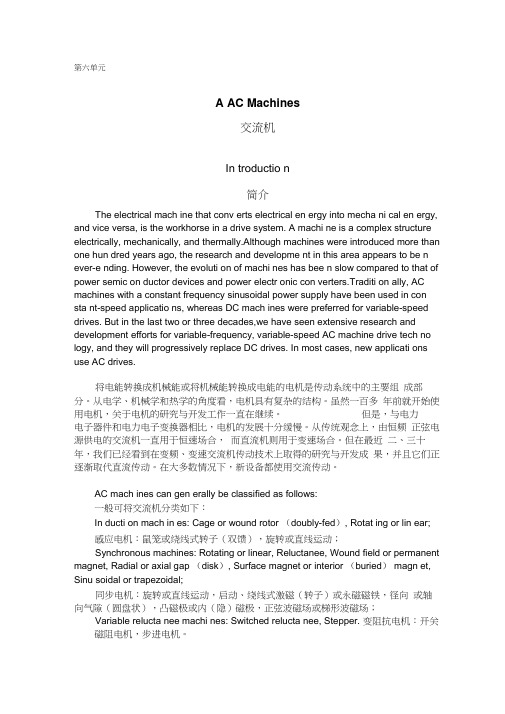
第六单元A AC Machines交流机In troductio n简介The electrical mach ine that conv erts electrical en ergy into mecha ni cal en ergy, and vice versa, is the workhorse in a drive system. A machi ne is a complex structure electrically, mechanically, and thermally.Although machines were introduced more than one hun dred years ago, the research and developme nt in this area appears to be n ever-e nding. However, the evoluti on of machi nes has bee n slow compared to that of power semic on ductor devices and power electr onic con verters.Traditi on ally, AC machines with a constant frequency sinusoidal power supply have been used in con sta nt-speed applicatio ns, whereas DC mach ines were preferred for variable-speed drives. But in the last two or three decades,we have seen extensive research and development efforts for variable-frequency, variable-speed AC machine drive tech no logy, and they will progressively replace DC drives. In most cases, new applicati ons use AC drives.将电能转换成机械能或将机械能转换成电能的电机是传动系统中的主要组成部分。
自动化专业英语翻译
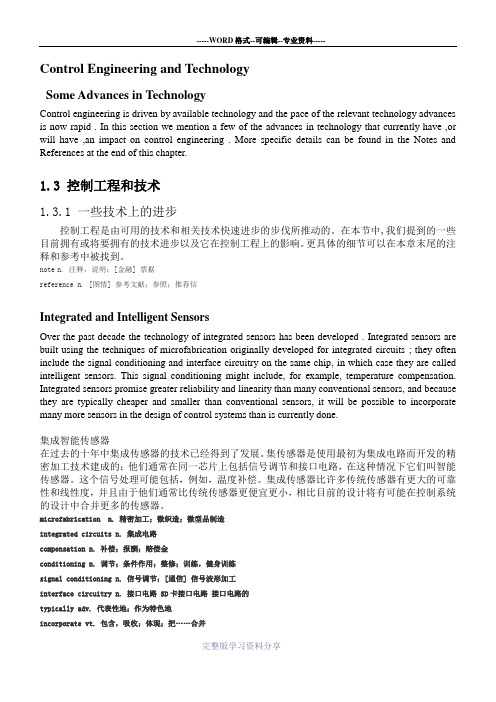
Control Engineering and TechnologySome Advances in TechnologyControl engineering is driven by available technology and the pace of the relevant technology advances is now rapid . In this section we mention a few of the advances in technology that currently have ,or will have ,an impact on control engineering . More specific details can be found in the Notes and References at the end of this chapter.1.3 控制工程和技术1.3.1 一些技术上的进步控制工程是由可用的技术和相关技术快速进步的步伐所推动的。
在本节中,我们提到的一些目前拥有或将要拥有的技术进步以及它在控制工程上的影响。
更具体的细节可以在本章末尾的注释和参考中被找到。
note n. 注释,说明;[金融] 票据reference n. [图情] 参考文献;参照;推荐信Integrated and Intelligent SensorsOver the past decade the technology of integrated sensors has been developed . Integrated sensors are built using the techniques of microfabrication originally developed for integrated circuits ; they often include the signal conditioning and interface circuitry on the same chip, in which case they are called intelligent sensors. This signal conditioning might include, for example, temperature compensation. Integrated sensors promise greater reliability and linearity than many conventional sensors, and because they are typically cheaper and smaller than conventional sensors, it will be possible to incorporate many more sensors in the design of control systems than is currently done.集成智能传感器在过去的十年中集成传感器的技术已经得到了发展。
自动化专业英语原文和翻译

自动化专业英语原文和翻译英文原文:Automation is the technology by which a process or procedure is performed with minimal human assistance. Automation or automatic control is the use of various control systems for operating equipment such as machinery, processes in factories, boilers, and heat treating ovens, switching on telephone networks, steering, and stabilization of ships, aircraft, and other applications and vehicles with minimal or reduced human intervention. Some processes have been completely automated.自动化是一种通过最少的人力辅助来执行过程或程序的技术。
自动化或自动控制是使用各种控制系统来操作设备,例如机械、工厂中的工艺流程、锅炉和热处理炉、电话网络的开关、船舶、飞机和其他应用和车辆的控制和稳定,从而实现最小化或减少人类干预。
一些过程已经完全自动化。
Automation plays a crucial role in various industries and sectors, including manufacturing, transportation, healthcare, and many others. It involves the use of advanced technologies and control systems to streamline processes, improve efficiency, and reduce human error.In the manufacturing industry, automation is used extensively to carry out repetitive tasks, such as assembly line operations. This not only speeds up production but also ensures consistent quality and reduces the risk of accidents. Robots and robotic systems are commonly employed in manufacturing plants to handle tasks that are dangerous or require high precision.在制造业中,自动化被广泛应用于执行重复性任务,例如流水线操作。
自动化专业英语原文和翻译

自动化专业英语原文和翻译Automated Professional English Original Text and TranslationOriginal Text:Automation plays a crucial role in the field of engineering, particularly in the domain of industrial processes. It involves the use of control systems and information technologies to reduce human intervention, increase efficiency, and improve productivity.In the context of the automation industry, professionals need to have a strong command of English to effectively communicate and collaborate with international partners and clients. Therefore, it is essential for students studying automation to develop their English language skills, especially in technical and professional contexts.The curriculum for automation majors should include courses that focus on English for specific purposes, such as technical writing, presentations, and negotiations. These courses should provide students with the necessary vocabulary, grammar, and communication strategies to effectively convey complex technical information in English.In addition to language skills, automation professionals should also be familiar with industry-specific terminology and concepts. They should have a solid understanding of automation systems, robotics, control systems, and programming languages commonly used in the field. This knowledge will enable them to effectively communicate and work with colleagues and clients from different countries.Furthermore, automation professionals should be aware of the latest advancements and trends in the industry. They should stay updated on new technologies, regulations, and best practices. This can be achieved through continuous professional development, attending conferences, workshops, and participating in online forums and communities.Translation:自动化在工程领域中起着至关重要的作用,特别是在工业过程领域。
自动化专业英语原文和翻译
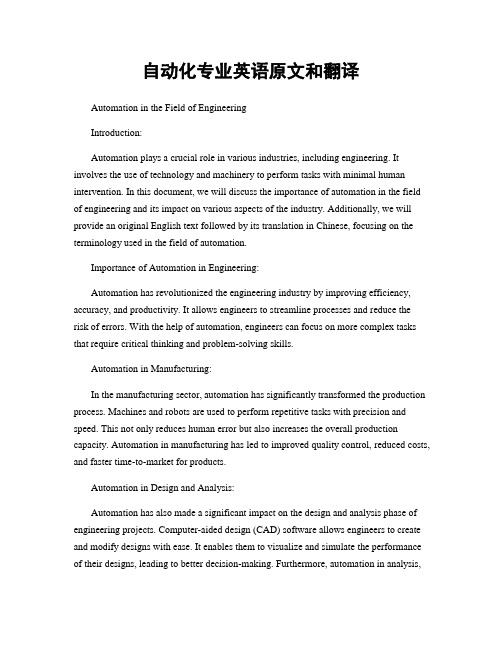
自动化专业英语原文和翻译Automation in the Field of EngineeringIntroduction:Automation plays a crucial role in various industries, including engineering. It involves the use of technology and machinery to perform tasks with minimal human intervention. In this document, we will discuss the importance of automation in the field of engineering and its impact on various aspects of the industry. Additionally, we will provide an original English text followed by its translation in Chinese, focusing on the terminology used in the field of automation.Importance of Automation in Engineering:Automation has revolutionized the engineering industry by improving efficiency, accuracy, and productivity. It allows engineers to streamline processes and reduce the risk of errors. With the help of automation, engineers can focus on more complex tasks that require critical thinking and problem-solving skills.Automation in Manufacturing:In the manufacturing sector, automation has significantly transformed the production process. Machines and robots are used to perform repetitive tasks with precision and speed. This not only reduces human error but also increases the overall production capacity. Automation in manufacturing has led to improved quality control, reduced costs, and faster time-to-market for products.Automation in Design and Analysis:Automation has also made a significant impact on the design and analysis phase of engineering projects. Computer-aided design (CAD) software allows engineers to create and modify designs with ease. It enables them to visualize and simulate the performance of their designs, leading to better decision-making. Furthermore, automation in analysis,such as finite element analysis (FEA), helps engineers predict the behavior of structures and systems under different conditions, ensuring safety and reliability.Automation in Construction:The construction industry has also embraced automation to enhance efficiency and safety. Robotic systems are used for tasks such as bricklaying, concrete pouring, and welding. These systems can work continuously without fatigue and perform tasks with precision, reducing the risk of accidents. Additionally, automation in construction allows for better project management, improved resource utilization, and faster completion times.Automation in Maintenance and Monitoring:Automation has revolutionized the field of maintenance and monitoring in engineering. Sensors and monitoring systems are used to collect real-time data on the performance of machines and structures. This data is then analyzed using automation techniques to detect anomalies and predict failures. By implementing proactive maintenance strategies based on automation, engineers can prevent costly breakdowns, minimize downtime, and optimize the lifespan of assets.Automation Terminology - English and Chinese Translation:Original English Text:1. Programmable Logic Controller (PLC): A digital computer used for automation of electromechanical processes.2. Human-Machine Interface (HMI): A graphical user interface that allows operators to interact with automation systems.3. Supervisory Control and Data Acquisition (SCADA): A system used for remote monitoring and control of industrial processes.4. Distributed Control System (DCS): A control system used to manage and control complex processes in various industries.5. Internet of Things (IoT): The network of physical devices, vehicles, and other objects embedded with sensors, software, and connectivity.Chinese Translation:1. 可编程逻辑控制器(PLC):用于电机电子过程自动化的数字计算机。
- 1、下载文档前请自行甄别文档内容的完整性,平台不提供额外的编辑、内容补充、找答案等附加服务。
- 2、"仅部分预览"的文档,不可在线预览部分如存在完整性等问题,可反馈申请退款(可完整预览的文档不适用该条件!)。
- 3、如文档侵犯您的权益,请联系客服反馈,我们会尽快为您处理(人工客服工作时间:9:00-18:30)。
2010-2011学年度第一学期自动化系《专业英语》期末试卷(A )年级2007专业自动化 学号: 姓名:注:1、共120分钟,总分100分。
I 、 Translate the following words and expressions into English .(20%)1.差分间隙 The differential gap2.过渡周期 the transition period3.复位率 reduction rate4.逐次逼近法 successive approximation method5.增益裕度 Gain margin6.双位控制器two-bit controller7.非线性系统 Nonlinear Systems8.作用函数 role in the function9.动态系统 Dynamic SystemII 、 Translate the following words and expressions into Chinese .(10%)1. Actuating error signal 驱动错误信号2. Laplace transform 拉普拉斯变换3. load disturbance 负载扰动4. lag-lead compensator 滞后导致补偿————————————装————————————————订————————————————线————————5.steady-state behavior 稳态行为6.Reference input signal 参考输入信号7.Partial differential equation 偏微分方程8.Transient- response analysis 瞬态响应分析9.Root-locus methods 根轨迹的方法10.Process control system 过程控制系统III、Fill in the blanks with the corresponding English abbreviations.(10%)1.集成电路芯片ic chip2.脉宽调制PWM3.人工智能AI4.气关式AC5.运算放大器OP、OPA、OPAMP6.单输入单输出控制系统SISO7.可控硅SCR8.比例积分微分控制器PID9.场效应晶体管FETCSIIV、Translate the following sentences into Chinese.(15%)1.W e shall give a brief discussion of methods for reducing the effects ofexternal disturbances on the system performance.我们将简要地讨论在系统运行时减小外部扰动对系统影响的方法。
装2.Whatever the actual mechanism may be and whatever the form of theoperating power, the proportional controller is essentially an amplifier with an adjustable gain .无论实际的机构可能是什么和任何的动作功率的形状,比例的控制器用一个可调整增益本质上是一个放大器3.Generally speaking,the performance specifications should not be morestringent than necessary to perform the given task.一般来说,与实现给定设计任务的必要性相比,性能指标的要求不应该太苛刻。
4.In 1922 Minorsky worked on automatic controllers for steering ships andshowed how stability could be determined from the differential equations describing the system.1922年,迈那斯基研究用于驾驶船舶的自动控制器,并提出根据描述系统的微分方程可以决定定系统的稳定性。
5.In an experimental investigation of a dynamic system,if cause and effectare proportional,thus implying that the principle of superposition holds,then system can be considered linear.对一个动态系统做实验研究,当系统的输入和输出成比例则说明其满足叠加原理,那么该系统可以被认为是线性系统。
V、Translate the following sentences into English.(15分)1.机器的速度可通过内部的微型计算机自动调节得同包装速度一致。
The speed of the machine may be automatically regulated to pace the packing operation by an inner microcomputer2.PID控制器是一种在工业过程控制中使用得最为广泛的控制器。
The PID controller is most common of use in the industrial process control3.没有空气,地球的温度就会急剧变化。
Without air, the earth would undergo extreme changes in temperature.4.变化的电流以每秒绕地球8圈以上的速度在电话线上传播。
The changing electric current,at the speed of 8 laps / second circling the earth,isdisseminated through by the telephone line.5.数学模型是对一个实际物理系统动态特性的数学描述,微分方程和传递函数是最常用的形式。
The mathematical description of the dynamic characteristics of a system is called amathematical model, the most usual form are the differential equation and thetransfer-function.————————————A PLC works by continually scanning a program. We can think of this scan cycle as consisting of 3 important steps. There are typically more than 3 but we can focus on the important parts and not worry about the others. Typically the others are checking the system and updating the current internal counter and timer values.Step 1-CHECK INPUT STATUS-First the PLC takes a look at each input to determine if it is on or off. In other words, is the sensor connected to the first input on? How about the second input? How about the third… It records this data into its memory to be used during the next step.Step 2-EXECUTE PROGRAM-Next the PLC executes your program one instruction at a time. Maybe your program said that if the first input was on then it should turn on the first output. Since it already knows which inputs are on/off from the previous step, it will be able to decide whether the first output should be turned on based on the state of the first input. It will store the execution results for use later during the next step.Step 3-UPDATE OUTPUT STATUS-Finally the PLC updates the status of the outputs. It updates the outputs based on which inputs were on during the first step and the results of executing your program during the second step. Based on the example in step 2 it would now turn on the first output because the first input was on and your program said to turn on the first output when this condition is true.After the third step the PLC goes back to step one and repeats the steps continuously. One scan time is defined as the time it takes to execute the 3 steps listed above. Thus a practical system is controlled to perform specified operations as desired.1. A PLC may scan a program occasionally. (F )2.Firstly, The input terminal should be connect with the PLC . ( F )3.The PLC will store the input results for use later. ( )4.The PLC will write the new status of the outputs at last. ( )5.The time which takes to perform the 3 steps is defined as one scan time.( F )VII、Translate the following paragraph into Chinese.(10%)Design of GPS/GPRS bus stop automatic announcerAbstract: Through the GPRS network, necessary bus status information should be transmitted to the bus monitor dispatching center timely , and then through the center of the operation of PC software, to achieve the function of the monitoring , scheduling and updating information.Key words: automatic station report; information updating; monitoringDesign of GPS/GPRS bus stop automatic announcerDesign of Automatic Station Report System for Bus Based on GPS/•Abstract: Combining GPS positioning technology, the bus status (information location, speed, etc.) in real-time are collected and analyzed. When the bus is scheduled to arrive at the location, the automatic station report functions is realized. Through the GPRS network, necessary bus status information should be transmitted to the bus monitor dispatching center timely, and then through the center of the operation of PC software, to achieve the function of the monitoring, scheduling and updating information. SD card is used to memorize the information of a number of lines and MP3 audio files, it is facilitated to replace bus lines , and at the same time high-quality voice information play is realized.•Keywords: automatic station report; GPS; GPRS; information updating; monitoring;VIII、Translate the following paragraph into English.(10%)基于μPD78F0034单片机的出租车计费器的设计与实现摘要:介绍了基于μPD78F0034单片机和模块式结构的出租车计费器的软件和硬件设计方法。
